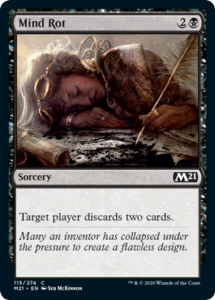My Arena Qualifier: Baldur’s Gate Sealed

This past weekend was Arena Qualifier weekend, which also happened to feature Baldur’s Gate Sealed deck. I spent a few hours practicing just the Sealed deck before the event and came to a couple of conclusions. Let’s take a peek at my deck and build.
Here’s my deck that I managed a 5-2 record with and was two wins short of advancing to day two.


Two photos to get a majority of the cards in the pool for consideration
My build was fairly obvious. While I had two great blue rares, I had only one or two other playable blue cards.


Black, clearly my best color, gave me four copies of Grim Bounty and my most powerful card, Ancient Brass Dragon. The Grim Bounties and Dragon almost single-handedly got me as far as I did. My deck looks very good from a conventional Sealed perspective, but unfortunately, most of the bomb rare creatures in this set aren’t cleanly answered by removal.
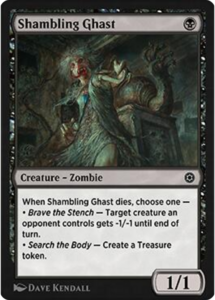

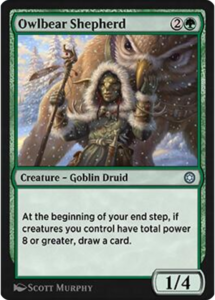
I opted for a very light white splash off the strength of the treasure from Grim Bounties and several other fixing sources. I often sided in an additional white card or two when my opponent’s cards were not aggressive. I would take out the Shambling Ghast for them, and in retrospect, I probably should have started the Circle of the Moon Druid over one Ghast, as it’s a respectable defensive body that can punish stumbles. Its most notable boon is helping out the pair of Owlbear Shepherds as they will see the 4 power in the end step.

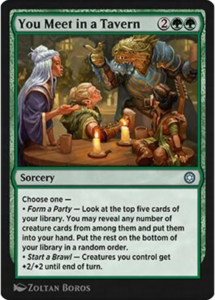
The Ghasts led me to playing Ambition’s Cost, a card I’m not that high on, and generally I never want more than a single copy. Taking a turn off is difficult since the board can snowball a lot, but you also get punished by paying three life to do so. With so many powerful creatures to find, I considered playing You Meet in a Tavern as a source of card advantage, but land drops were also critical with three seven-drops in my deck, so I decided to pay the cost to play the cost.

The only other card I didn’t consider too strongly was Minthara of the Absolute. It’s an incredibly powerful card, and with so much treasure you’d think I’d start it since it would be easy to trigger. However, I didn’t think it would progress my plan well, and it would punish me when I wasn’t able to cast it. I also wouldn’t get a trigger casting it off a treasure. It’s certainly possible I should have started it because it’s obscenely powerful, but I planned on winning long, controlling games and not running people over. I was mostly trading creatures as aggressively as possible, which would lead to playing a four-mana 2/4 that only pumped itself.

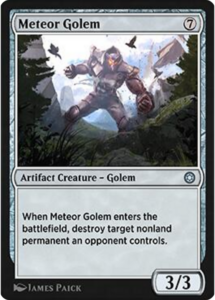

Scaled Nurturer is a card I’ve liked when I end up in green in draft, but in a deck like this I’m not trying to ramp to Meteor Golem even though that seems logical. Nurturers would be bad to play on any turn beside two, as I need to spend my mana midgame reacting to the opponent’s board. I’m winning games by casting two-for-ones Like Owlbear and slowly grinding out my opponent’s resources. Every game I won was when my opponent was empty-handed and ran out of threats while I beat them up with Owlbears or Ancient Brass Dragon. There were some games where my opponents let the Guildsworn Prowlers whittle them down to low-life totals before trading for them, which made the games easy to close but only when I drew two of them early.

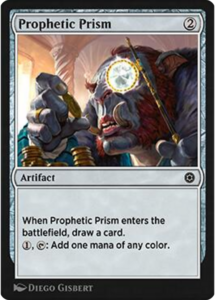
Prophetic Prism was my last inclusion after I cut the one Scaled Nurturer I was considering playing. I played the Prism to help cast Grim Bounties and Owlbears consistently on curve rather than to enable my splash. It’s possible it was too safe to play the Prism and I should have played another card with board impact, but it never punished me.


Overall, I’d rate my deck a six out of ten in this format. In traditional Sealed I’d rate it much higher when slowly grinding down opponents is more viable and cards like Lae’zel, Githyanki Warrior or Klement, Novice Acolyte don’t exist. I had the tools you’d want in most Sealed deck formats, but this just wasn’t one of them.

My match losses came at the hands of a Lae’zel, Githyanki Warrior and a Minsc & Boo, Timeless Heroes when I was on the backfoot in two games. I have beaten Minsc quite a few times, but it requires you to be ahead on board when it hits the battlefield. I had to blame single cards for why I lost an entire match, but these cards are too difficult to beat in some situations.

Regardless, there are also cards like The Hourglass Coven, which make it impossible to beat with a single removal spell. I managed to beat one player who successfully resolved the Coven but had multiple removal spells lined up for the copies it brought into play on a stalemate board. It was lucky that my opponent didn’t draw it in a closer game two.
While I wasn’t unhappy with my pool, I needed to dodge some of the format’s defining cards, and I did a terrible job of that when playing against opponents with lots of the best rares in the set.
This brings me to another point—I saw a lot of decks that looked mediocre that got to seven wins on day one, but they did have one or two of the format’s best rares. This is one of those formats I believe you should be going out of your way to play the format’s best cards because your best card is generally worth so much more than the quality of the bottom six or seven spells. These people saw busted rares and correctly identified they needed to play them regardless if their last few slots were bad. In some Sealed formats, it can be a trap to open a very good Mythic, not have a supporting cast for it, and try and force the issue. This is not one of those formats. The best cards are so much better than a tier below them that the games center around those cards.
I went in hoping to play some sort of aggressive deck with one or two rares, but if not, I want to be aggressive. One way to win in this format against a lot of the rares is by pulling far enough ahead and spending mana early so if the cards are played off curve, or even in some cases on, you’ll be able to find lethal before they take over.
You don’t want to play long games against the format’s top rares. In traditional Sealed, you can clean answer some of the formats most powerful cards with cards like Cancel, Disdainful Stroke, and even various Mind Rot effects. Baldur’s Gate’s problem is the color imbalance is so out of line that even with two great blue rares I couldn’t find enough playables to play blue. You’re unlikely to be able to play blue correctly and to need the battlefield clean to hold up mana for counterspells. This is too hard to do while you’re dying to two-mana Double Team commons.
Mind Rot does exist in this format. It’s even closer to Blightning as it does damage, but I’m not a fan of it because of how aggressive the format can be. Double Team hurts it as the extra copy of the creature in hand can protect other better cards in hand, but it also ensures that the opponent can spend their mana proactively while you’re spending three mana to not influence the battlefield at all.
Moving forward, and outside of extreme circumstances, I plan to ignore blue and focus mostly on the Mardu colors when I play the Arena Open. These colors have the best mix of rares and specialize uncommons, which means you’ll typically lean towards playing those in Sealed.
I plan to do this for day two in the drafts. I’ve had some minor success drafting blue, but it’s not worth the risk with money on the line. I wasn’t aware last time, but the Arena Open players on day two aren’t drafting against each other. Instead, they’re drafting in the queue of normal ladder players. This means everyone can show up with a busted RW or BW Aggro deck with the format’s best cards.
Normally, you’d expect the drafts to be self-balancing. In this case, with the color imbalance and people in your queue playing ladder or just for fun, I believe it’s correct to run hot with the best colors and draft a solid deck of the good cards rather than gamble and put together a playable blue deck.
The money only comes when you escape the first draft with a 3-0, so trainwrecking is basically the same as drafting a good deck and going 2-1, if the gems aren’t why you’re playing. I know many people say just draft a consistent deck and there’s no deck that is sure to 3-0. They can be right in many cases, but here it means taking riskier picks in the draft, speculating more aggressively, and focusing solely on the format’s best colors by ignoring blue and maybe green, the second worst color. This could lead to a deck that is unlikely to win matches, but losing any matches in the first draft eliminates you, so it’s worth it to try and end up with a good deck in the Mardu colors because those decks will be much better than the best decks with blue in them.
The second draft of the day you get money per win, so it makes more sense to be more conservative and draft a deck that can win. Most of all, I’d just do what you’re comfortable doing in the Open. My personal preference is to risk it for the biscuit.
So that was how my weekend went. I’m hoping to make next weekend’s open a nice payday. I’ll see you on the battlefield this weekend!
Image Copyright: (c) 1995-2020 Wizards of the Coast LLC, All Rights Reserved







